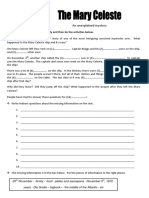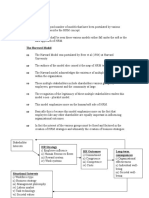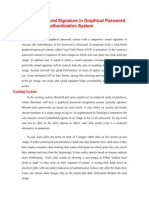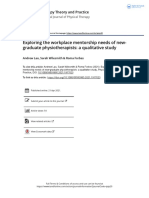Best Practice Approach
Best Practice Approach
Uploaded by
shahidCopyright:
Available Formats
Best Practice Approach
Best Practice Approach
Uploaded by
shahidOriginal Description:
Original Title
Copyright
Available Formats
Share this document
Did you find this document useful?
Is this content inappropriate?
Copyright:
Available Formats
Best Practice Approach
Best Practice Approach
Uploaded by
shahidCopyright:
Available Formats
Increasingly, organizations are finding that to survive they must cooperate with organizations
around the world. Companies/organizations must both defends their domestic markets from
foreign competitor and broaden their scope to encompass global markets. In order to reach the
goal of organizations/companies HRM play the important role to run the business and make the
good business environment to create smoothly work and also compete with the other to gain
competitive advantage by expansion to the global area/broaden, integration of cultures & values,
got and received the feedback from the consumers to develop the product and service, training
staff many time and encourage getting high competencies. To succeed in the global marketplace,
the challenge for all business is to understand culture and invest in human resources.
The term human resource management was being used by Peter Drucker
and others in North America as early as the 1950s without any special
meaning, and usually simply as another label for personnel management or
personnel administration. By the 1980s, however, HRM had come to mean a
radically different philosophy and approach to the management of people at
work (Storey, 1989; pp45) with an emphasis on performance, workers
commitment, an rewards based on individual or team contribution, differing
significantly in all of these from the corresponding aspects of traditional
personnel management. One of the main characteristics of HRM is the
devolution of many aspects of people management from specialists directly
to line managers. HRM itself has been called the discovery of personnel
management by chief executives. So line managers over the past ten years
or so have frequently been confronted with HRM decisions and activities in
their day-to-day business in a way that was not the case previously.
http://www.researchersworld.com/vol4/vol4_issue1_1/Paper_09.pdf
Best practice approach
The best practice approach claims that certain bundles of HR activities exist
which universally support companies in reaching a competitive advantage
regardless of the organizational setting or industry (Redman and Wilkinson
2009). Best practice models imply a close connection between HR practices
and organizational performance and are often associated with high
commitment management (Paauwe & Boselie 2003). Empirical research in
the best-practice field shows similar groups of HR polices which are
especially suitable for maximizing performance irrespective of market and
product strategies (Peffer 1998, Guest 2000). Best practice bundles of
activities are characterized as mutually compatible HR activities which forge
high levels of workforce competence, encourage motivation and introduce a
workdesign boosting employee commitment (Maloney and Morris 2005).
Based on concepts from expectancy theory (Vroom 1964, Lawler 1971) best
practice HR will result in higher levels of quality, productivity and low rates of
absenteeism and wastage (Guest 2000).
The best practice approach suffers from a series of limitations. Firstly, when
implementing best practice standards organizations run risk of introducing
mutually prohibitive combinations like team working and compensation
based on individual performance resulting in a deterioration of employee
collaboration through overexaggerated competition (Delery 1998 in Redman
and Wilkinson 2009). Secondly, high commitment management systems are
generally a complex undertaking requiring large inputs of planning and top
level management commitment. Thirdly, critics like Milkovich and Newman
(2002) argue that best practice HR lacks direct linkages with organizational
strategies and is minted by the belief that outstanding high performing
human resources will influence strategy. By making HR policy precede
corporate strategy an organization risks prescribing standardized sets of
"one size fits all" best practice approaches which will not support the
particular needs of employees and be detrimental to overall strategic
objectives (Maloney and Morris 2005). Fourthly, discussions with regard to
the appropriate choice of best practice measures resulting from an
insufficient research methodology and theoretical definition exist
(Marchington and Grugulis 2000 in Redman and Wilkinson 2009).
Best fit approach
The best-fit model is considered as a variant from precedent models of
Harvard, Michigan and York and is called "matching model" for HRM (Sparrow
and Hiltrop 1994). It is based on developing HRM policies according to
business strategy. Strategy involves planning future activities, performances
objectives, and policies towards reaching the corporate aims. HRM strategy
should be designed and applied to support the given corporate strategy
(Lawler 1995). The "best-fit" approach questions the universality assumption
of the best-practice perspective. It emphasizes contingency fit between HR
activities and the organization's stage of development, an organization's
internal structures and its external environment like clients, suppliers,
competition and labour markets (Redman and Wilkinson 2009). HR policy
should be minted by the appropriate context of individual employees and
therefore support the overall competitive strategy. Aligning HRM practices to
strategies can enable companies to create potential competitive advantages
(Schuler and Jackson 1987 in Redman and Wilkinson 2009).
The best fit approach is also subject to sever criticism. Firstly, Boxall and
Purcell (2003) criticizes that in a changing business environment companies
and their strategies are subject to multiple alternating contingences and that
it is merely possible to adjust entire HR systems to new challenges
frequently. Secondly, as companies move through their life-cycle HR
practices have to be aligned which leads to an alternating treatment of
employees which can have a demotivating effect and show inconsistency in
corporate culture (Boxall and Purcell 2003).
You might also like
- Article On Best Fit Vs Best PracticeDocument4 pagesArticle On Best Fit Vs Best Practiceashkhan199950% (2)
- Critical Evaluation of "Best Practice" and "Best Fit" Practices in HRMDocument3 pagesCritical Evaluation of "Best Practice" and "Best Fit" Practices in HRMTUMMALAPENTA BHUVAN SAI KARTHIKNo ratings yet
- The Mary Celeste Mystery ReadingDocument2 pagesThe Mary Celeste Mystery ReadingEmilio Hernandez50% (4)
- Higgs and DulewiczDocument2 pagesHiggs and DulewiczshahidNo ratings yet
- What Is Strategic ThinkingDocument6 pagesWhat Is Strategic ThinkingMarco AlvarezNo ratings yet
- SLB - ALS - Catalog PDFDocument236 pagesSLB - ALS - Catalog PDFMohamed Shafie100% (1)
- HRM RoleDocument95 pagesHRM RoleSri Ganesh ComputersNo ratings yet
- Hasliza Abdul-Halim and Norbani Che-Ha, PHDDocument15 pagesHasliza Abdul-Halim and Norbani Che-Ha, PHDNeha ShrivastavaNo ratings yet
- STRATEGIC Assignment 1Document5 pagesSTRATEGIC Assignment 1Tinotenda MariahNo ratings yet
- SHRM 1Document47 pagesSHRM 1Arooj ShabbirNo ratings yet
- Review of Schuler and Jackson Model of StrategicDocument10 pagesReview of Schuler and Jackson Model of StrategicAlex Munyaka100% (2)
- Litrechar Review On HR PractisesDocument14 pagesLitrechar Review On HR Practisessharmashital60No ratings yet
- Concept and Issues: Strategic Human Resources ManagementDocument22 pagesConcept and Issues: Strategic Human Resources ManagementGangadhar MamadapurNo ratings yet
- Implementing HRM Strategies To ImproveDocument16 pagesImplementing HRM Strategies To ImproveKazi Nazrul Islam100% (1)
- Harvard ModelsDocument7 pagesHarvard ModelsGlady's Deepz100% (1)
- HRM AssignmentDocument12 pagesHRM Assignmentdropkick94No ratings yet
- Links Between Business Strategy and Human Resource Management Strategy in Select Indian Banks: An Empirical StudyDocument19 pagesLinks Between Business Strategy and Human Resource Management Strategy in Select Indian Banks: An Empirical StudychecklogsNo ratings yet
- Steve Galea 405099M Managing Human Capital and Leadership AssignmentDocument16 pagesSteve Galea 405099M Managing Human Capital and Leadership AssignmentSteve and FriendsNo ratings yet
- SHRM Assignment FinalDocument13 pagesSHRM Assignment FinalmekamuNo ratings yet
- Lecture 3 - Strategic Human Resource ManagementDocument18 pagesLecture 3 - Strategic Human Resource ManagementCharleyNo ratings yet
- 4.boxall, Peter. Strategic Human Resource ManagementDocument4 pages4.boxall, Peter. Strategic Human Resource Managementmiudorina100% (2)
- Business Strategy and HRMDocument19 pagesBusiness Strategy and HRMarchanam123No ratings yet
- HR Audit ChapterDocument43 pagesHR Audit ChapterZainUdDinNo ratings yet
- Eresearch: The Open Access Repository of The Research Output of Queen Margaret University, EdinburghDocument30 pagesEresearch: The Open Access Repository of The Research Output of Queen Margaret University, EdinburghErin LeeNo ratings yet
- HRM Assignment Task Rev2Document22 pagesHRM Assignment Task Rev2Anthony Gregory100% (2)
- HRM BookDocument20 pagesHRM BookMihir GhaelNo ratings yet
- Kerry FoodsDocument18 pagesKerry Foodshailu ayalewNo ratings yet
- An Zam Proceed VersDocument14 pagesAn Zam Proceed Versengmostafa_2007No ratings yet
- HRM AssignmentDocument8 pagesHRM AssignmentMohammed AfzaalNo ratings yet
- Chapter TwoDocument39 pagesChapter TwoisaacdenenNo ratings yet
- HRM Practices/Strategies & Firm Performances: Literature Review'Document6 pagesHRM Practices/Strategies & Firm Performances: Literature Review'Farwa RajputNo ratings yet
- Best Practice Universalist TheoryDocument13 pagesBest Practice Universalist TheoryJosephine Benjamin67% (3)
- HR Policy and Business StrategyDocument15 pagesHR Policy and Business Strategylccmich67% (3)
- Human Resource ManagementDocument13 pagesHuman Resource Managementkumarsarvesh90No ratings yet
- Strategic Management Literature ReviewDocument8 pagesStrategic Management Literature Reviewafdtrajxq100% (1)
- Strategic Human Resource Management in Small and Growing Firms: Aligning Valuable ResourcesDocument22 pagesStrategic Human Resource Management in Small and Growing Firms: Aligning Valuable ResourcesFadzlli AminNo ratings yet
- Strategic Human Resources: A New Source For Competitive Advantage in The Global ArenaDocument17 pagesStrategic Human Resources: A New Source For Competitive Advantage in The Global ArenaPMVC06No ratings yet
- Essentials+ (chapter+6-+Human+Resource+Strategy )Document21 pagesEssentials+ (chapter+6-+Human+Resource+Strategy )Noemi G.No ratings yet
- Towards An Integrated Model of Strategic Human Resource Management - An Australian Case StudyDocument16 pagesTowards An Integrated Model of Strategic Human Resource Management - An Australian Case StudyGoutham ThallapureddyNo ratings yet
- Integrated Model of HRMSDocument10 pagesIntegrated Model of HRMSAsad Maimun Al FatiechNo ratings yet
- Strategic Human Resource Management Concept and ProcessDocument3 pagesStrategic Human Resource Management Concept and ProcessAbhinav JanbandhuNo ratings yet
- Rainier Storm 0827405 Advanced Human Resource ManagementDocument12 pagesRainier Storm 0827405 Advanced Human Resource ManagementRainier StormNo ratings yet
- Defining Strategic HRDDocument41 pagesDefining Strategic HRDBarzala CarcarNo ratings yet
- Best FitDocument21 pagesBest FitSimone Jadoo-AlieNo ratings yet
- HR Strategies Vs Competitive WorldDocument9 pagesHR Strategies Vs Competitive WorldShiny SNo ratings yet
- Competitive Advantages Through PeopleDocument7 pagesCompetitive Advantages Through PeopleClaudia Huajardo0% (1)
- HRM EssayDocument3 pagesHRM EssayMuhammad KharrisNo ratings yet
- Changing Roles in Strategic Human Resources Management in International BusinessDocument5 pagesChanging Roles in Strategic Human Resources Management in International BusinessAce Marlo SardeaNo ratings yet
- Human Resource Management in International OrganizationsDocument5 pagesHuman Resource Management in International Organizationsapadanainst7372100% (3)
- Salman HRMDocument2 pagesSalman HRMSalman QureshiNo ratings yet
- Dennis M. Daley (2002) Human Resource Management Has Surfaced Forcibly As TheDocument13 pagesDennis M. Daley (2002) Human Resource Management Has Surfaced Forcibly As TheHasam Mohamad Al BousabiNo ratings yet
- Question OneDocument9 pagesQuestion OneAbdela Aman MtechNo ratings yet
- Literature Review Human Resources ManagementDocument5 pagesLiterature Review Human Resources Managementauhavmpif100% (1)
- Developing Employer of Choice' Status: Exploring An Employment Marketing MixDocument28 pagesDeveloping Employer of Choice' Status: Exploring An Employment Marketing MixMahmuda RahmanNo ratings yet
- Business Strategies of Discount RetailerDocument14 pagesBusiness Strategies of Discount RetailerMatthew BellaNo ratings yet
- 23 ICAB Hashim Fadzil AriffinDocument13 pages23 ICAB Hashim Fadzil AriffinShalu SuntariNo ratings yet
- Maslow - Applications and CriticismDocument6 pagesMaslow - Applications and CriticismDana Danutza100% (1)
- SHRM Best-Practices & Sustainable Competitive Advantage: A Resource-Based ViewDocument17 pagesSHRM Best-Practices & Sustainable Competitive Advantage: A Resource-Based ViewAhmer A. Nadeem100% (1)
- The Nestlé Human Resources PolicyDocument24 pagesThe Nestlé Human Resources Policyamanpreet0% (1)
- BUS3022 - Strategic HRM Assignment Essay Question 2 Student No: 071087047 Word Count: 2193 25/11/09Document8 pagesBUS3022 - Strategic HRM Assignment Essay Question 2 Student No: 071087047 Word Count: 2193 25/11/09Saif121No ratings yet
- HRM370Document6 pagesHRM370siddiquerifat99No ratings yet
- Staffing to Support Business StrategyFrom EverandStaffing to Support Business StrategyRating: 2.5 out of 5 stars2.5/5 (3)
- 1.1 Bargaining Power of Buyer: Bumgt 3702 Strategic ManagementDocument14 pages1.1 Bargaining Power of Buyer: Bumgt 3702 Strategic ManagementshahidNo ratings yet
- IMS Billiards 8ball RulesDocument4 pagesIMS Billiards 8ball RulesshahidNo ratings yet
- Bouncy BallsDocument2 pagesBouncy BallsshahidNo ratings yet
- Sample PDF Document: Created With Adobe Acrobat 7Document1 pageSample PDF Document: Created With Adobe Acrobat 7shahidNo ratings yet
- tv0403 - EIDocument32 pagestv0403 - EIshahidNo ratings yet
- Income Approach DesignDocument4 pagesIncome Approach DesignshahidNo ratings yet
- Integration of Sound Signature in Graphical Password Authentication SystemDocument4 pagesIntegration of Sound Signature in Graphical Password Authentication SystemRAJESH BHATTNo ratings yet
- Question Bank 3 and 4 UnitDocument8 pagesQuestion Bank 3 and 4 Unitanlacetech133No ratings yet
- Baturina Tatiana Doll TatianaDocument26 pagesBaturina Tatiana Doll TatianaYasna Chávez Vargas100% (1)
- Business Roles in FamiliesDocument3 pagesBusiness Roles in FamiliesDENSHNo ratings yet
- API 510 2014 Mumbai PDFDocument2 pagesAPI 510 2014 Mumbai PDFBurapha Malutphanth33% (3)
- Student SyllabusDocument1 pageStudent SyllabusAnurag PokhriyalNo ratings yet
- OutlinesofancientDocument211 pagesOutlinesofancientpstrlNo ratings yet
- CBDBDocument12 pagesCBDBwas asdNo ratings yet
- Adamczyk Resume 2019 5Document2 pagesAdamczyk Resume 2019 5api-511630954No ratings yet
- Exploring The Workplace Mentorship Needs of Newgraduate Physiotherapists. A Qualitative StudyDocument11 pagesExploring The Workplace Mentorship Needs of Newgraduate Physiotherapists. A Qualitative StudyWoffe SoloNo ratings yet
- Application of Biomaterials in DentistryDocument4 pagesApplication of Biomaterials in DentistrywdtalampasNo ratings yet
- Group Oral PresentationDocument2 pagesGroup Oral PresentationRodrick RamosNo ratings yet
- Automotive Charging System Purpose: - Convert Mechanical Energy To Electrical EnergyDocument2 pagesAutomotive Charging System Purpose: - Convert Mechanical Energy To Electrical EnergyDimson B. CabacangNo ratings yet
- Society of Spanish & Spanish-American Studies Anales de La Literatura Española ContemporáneaDocument19 pagesSociety of Spanish & Spanish-American Studies Anales de La Literatura Española ContemporáneaLl JournalNo ratings yet
- China Pump Market ReportDocument10 pagesChina Pump Market ReportAllChinaReports.com0% (1)
- Ewsco 2022 350615Document1 pageEwsco 2022 350615Rishu RajNo ratings yet
- Ingles Rainier 12Document19 pagesIngles Rainier 12Evelin RojasNo ratings yet
- 1 AC 200 282C ILT 001 Syllabus Introduction AppendicesDocument36 pages1 AC 200 282C ILT 001 Syllabus Introduction AppendicesaaaguilarmNo ratings yet
- TSL - Total Student Load - Book ReviewDocument2 pagesTSL - Total Student Load - Book ReviewRoss FreshwaterNo ratings yet
- J&T ExpressDocument1 pageJ&T ExpressDiane SaibonNo ratings yet
- Bug AlgorithmsDocument15 pagesBug AlgorithmsAshNo ratings yet
- Floating Solar Handbook 2019-World Bank & SERISDocument155 pagesFloating Solar Handbook 2019-World Bank & SERISSRINIVASAN T100% (4)
- Triptico InglesDocument2 pagesTriptico InglesBere AriasNo ratings yet
- Accent ReductionDocument29 pagesAccent ReductionVishakha NoopurNo ratings yet
- Patterns of Development DefinitionDocument24 pagesPatterns of Development DefinitionIrene Tagalog100% (1)
- SAILMA Grades Steel Plates & SheetsDocument2 pagesSAILMA Grades Steel Plates & SheetsElumalai SrinivasanNo ratings yet
- Assignment L01 (Thursday, 11.30 Am) Marking SchemeDocument12 pagesAssignment L01 (Thursday, 11.30 Am) Marking SchemeMawareNo ratings yet
































































































